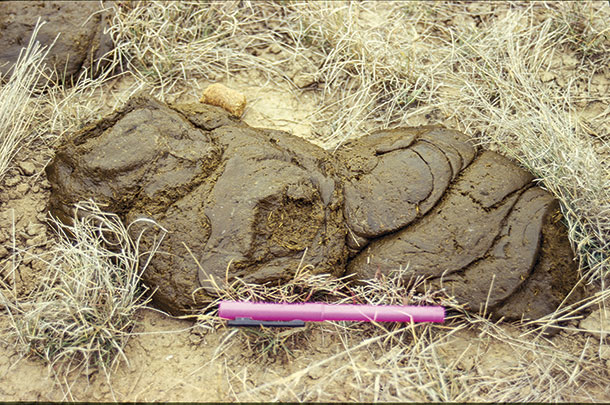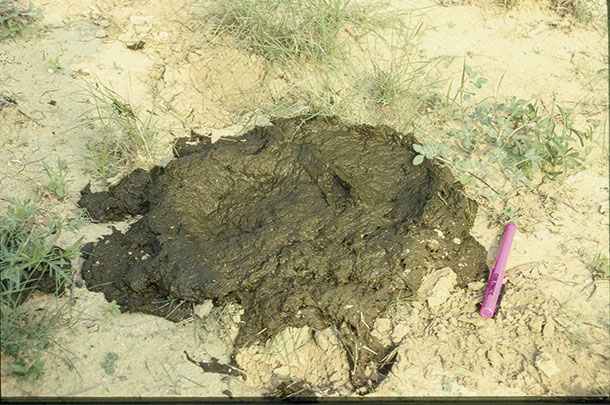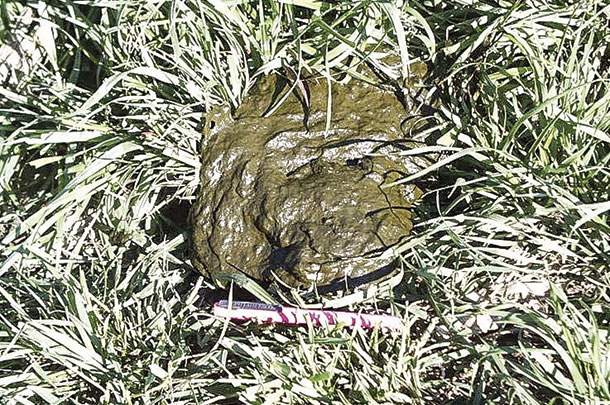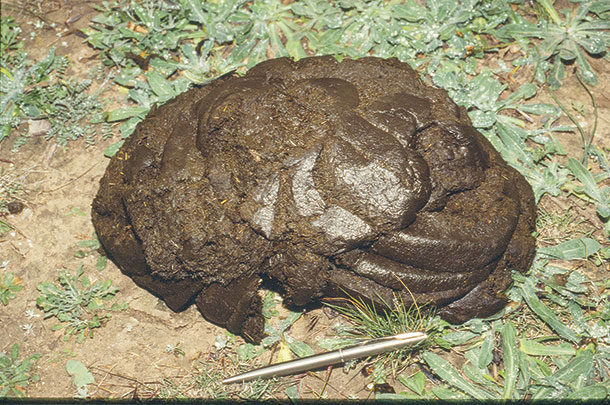Management of beef cattle nutrition should be based on the quantity and quality of forage as well as animal considerations such as body condition score, physiological status and production goals.
However, estimating the quality of forage consumed by grazing animals is difficult. First, the quality of forage changes seasonally. Second, in rangeland environments, animals can choose from numerous plant species and select specific plant parts. This selectivity frequently changes the diet composition and makes it difficult to tell exactly what these animals are eating.

For some time, it has been recognized that a relationship exists between forage quality and the physical appearance of feces of grazing cattle.
Grazing cattle primarily eat grasses and forbs (herbaceous broadleaf plants). New plant growth, mostly leaves, contains high levels of easily digestible compounds such as proteins, sugars and lipids. New plant growth has very little fiber in the form of cellulose or cellulose-lignin complexes.
Therefore, cattle droppings that result from the consumption of immature, high-quality forages tend to fall to the ground in relatively shapeless deposits. As grasses mature, the fibrous content increases, and the appearance of cattle droppings reflects a lower-quality diet high in fiber.

To interpret the relationship between forage quality and fecal appearance, the following Photo Guide to Forage Quality can be used. The guide features four broad forage quality categories that are indicators of forage quality.
Forage quality categories are divided on a crude protein basis because this approach provides the clearest relationship to visual changes in droppings. Some overlap of digestibility values exists between the middle two crude protein levels.
Forage quality estimates were obtained using near-infrared reflectance spectroscopy fecal analysis. While this guide serves as, and is meant to be, a general indicator of forage diet quality, more precise estimates can be obtained through near-infrared reflectance spectroscopy fecal analysis.
Forage quality and nutritional management
Forage quality must be interpreted in relation to the status of the animals being managed. Be sure to consider the animal’s physiological status (dry, lactating, growing), body condition score (to determine performance goals) and production goals (maintenance versus gain).

Body condition scores are good nutritional management indicators. These scores reflect past forage quality and quantity levels, but they also indicate future management needs.
Forage quality is important, but so is forage availability. There are several indicators that may provide clues to forage availability.
Cattle have strong forage preferences. Even though grass is their preferred food, some grasses are more palatable, and cattle will search for these specific grasses. Having “a lot of grass” does not necessarily mean cattle will perform at the desired level if very little of the desired grass is available.

Cattle diets typically consist of more than 80 percent grass and other herbaceous plants. Cattle are not efficient at eating browse (leaves of woody plants), and normal diets usually contain less than 7 percent browse. If cattle spend time eating browse, it is a good indicator available forage is limited. Performance most likely will suffer once browse in the diet reaches 10 percent.
Cattle have fairly definite grazing patterns. Typically, there are three major daily grazing periods – long periods at dawn and late afternoon and a short one near midnight. Cattle graze to fill a need for quantity. Cattle grazing in the midday summer heat probably do not have enough grass to meet their needs. ![]()
PHOTO 1: This dropping indicates a forage crude protein level between 6 percent and 9 percent. Digestibility is from 58 percent to 63 percent, a slight overlap with the crude protein level of 10 percent to 17 percent. At this forage quality level, a dropping exhibits flat folds. As forage quality increases within this range, the folds become smaller. This dropping indicates forage quality is adequate to supply maintenance requirements for mature cows. Minimal weight gain in replacement heifers and stocker cattle should be expected.
PHOTO 2: This dropping indicates a forage crude protein level between 10 percent and about 17 percent, and a digestibility of 61 percent to 67 percent. Notice the slight crater-like appearance in the surface of this sample. In the 10 percent to 13 percent crude protein range, small folds may be present in the dropping. Supplementation, or the addition of protein and energy to the diet, is not required for mature cows. Forage which creates droppings like this should support 1 pound to 1.5 pounds average daily gain on heifers and steers.
PHOTO 3: This dropping indicates a forage crude protein greater than 20 percent and digestibility of 70 percent to 80 percent. The dropping forms around whatever is beneath it, with little shape of its own. Also, notice the dark green color. The high-quality forage is typically associated with cool-season winter forages such as small grains or ryegrass. Nutrient (protein and energy) availability exceeds the cattle’s requirements for maintenance, growth or lactation.
PHOTO 4: This cattle dropping indicates a forage crude protein level of 5 percent or less and digestibility at or below 56 percent. Notice the distinct rings in the lower right portion of the dropping. These rings tend to be firm. Droppings such as this tend to stack; however, stacking without the distinct hard rings is not characteristic of this forage quality level. This dropping indicates forage is below the maintenance requirements for all classes of beef cattle. Forage digestibility and intake may increase with protein supplementation. Note that increased levels of activity can result in loose droppings. Evaluate the consistency of cattle droppings only after a rest period. Photos provided by Robert Lyons.
Robert K. Lyons is a professor and extension range specialist with Texas A&M AgriLife Extension Service. Email Robert K. Lyons.








